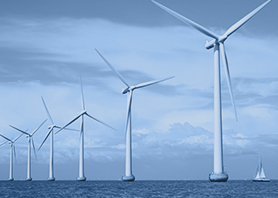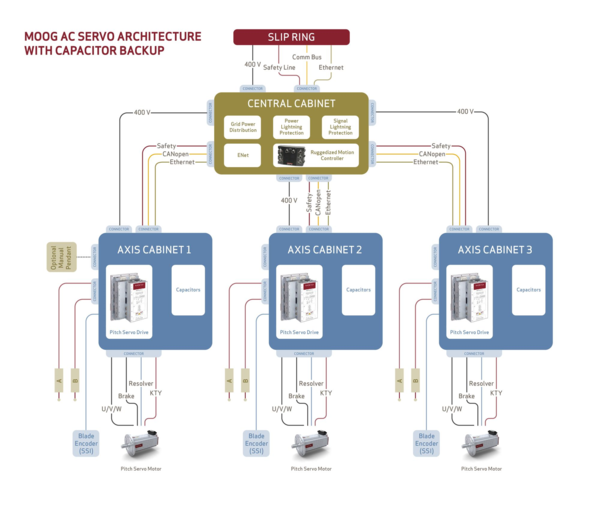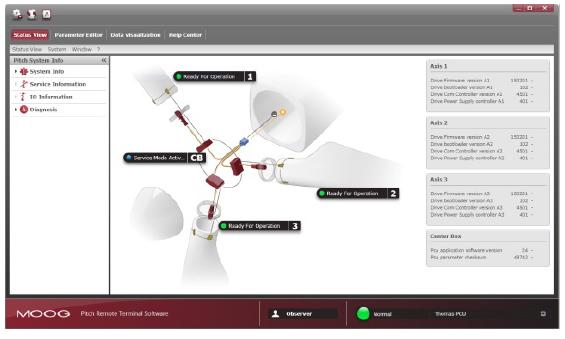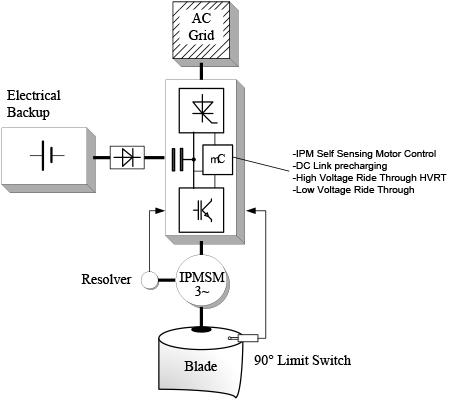
In this article:
- More demanding offshore operations and the need for longer turbine life drives the importance of high performance pitch control
- Innovations in AC architecture, software and closed loop speed control continue to boost productivity and ensure safety
- Experience and customer focus are the keys to choosing a pitch control provider
As wind turbines are increasingly located in harsh and remote offshore environments, reliable motion control systems are required to ensure a consistent power generation source. Moog has worked with its customers to continue to develop pitch systems, products and services that improve overall reliability and maximize availability, while ensuring the safety of the turbine and operator. A recent enhancement to the Moog AC Pitch System is the self-sensing speed control for turbines that was developed to prevent blades from not being able to move in the event of an encoder failure—the worst case load scenario for the wind turbine.
Wind energy is growing and turbine manufacturers must continually innovate
Wind is an energy source that has been intensively used since ancient times. Driven by the rising global demand for energy and by growing environmental awareness, an increasing amount of research and development is being conducted in the field of modern wind turbines for power generation. Of all the renewable energy sources, wind power currently accounts for the greatest share of energy produced yet it still offers considerable potential for expansion. In light of the global trend towards using renewable energy sources, governments and utilities are searching for larger, better-performing wind turbines for installation in harsh onshore and offshore locations.
Compared to onshore, offshore has nearly unlimited space available, fewer operational limitations and no height and rotor diameter restrictions which encourage larger and better performing turbines. This also creates operational issues and expensive downtime as access to the turbines for repair operations is often restricted or even impossible during strong wind and high waves. As a result, wind turbine OEMs are faced with new and increasingly complex system performance challenges. Fortunately, new motion control solutions for wind turbines are helping to overcome these obstacles.
One of the most important, but least appreciated technologies that keeps a wind turbine functioning is its pitch system. The pitch system monitors and adjusts the angle of the wind turbine blades, which controls the rotation speed of the rotor. It is often less than 3% of the wind turbine's overall cost, but is responsible for a high degree of its safety and efficiency. As turbines grow in size and locations become more remote, designers and manufacturers of pitch systems must continually seek innovation.
Two key requirements
A wind turbine pitch control system must fulfill two essential functions: First, it performs as an actuator to control turbine speed and power when the wind speed exceeds the turbine’s rated values. Secondly, it acts as the actuator for the wind turbine braking system. Pitch systems must also meet regulatory requirements (e.g., GL 2010, ISO 13849) and withstand extended temperature ranges from -40 °C (-40 °F) outside the cabinets up to 70 °C (158 °F) inside the cabinets to perform reliably in extreme offshore or onshore environments.
Turbine manufacturers and operators focus on two primary requirements of pitch systems:
- Improve the turbine’s overall reliability and maximize availability through higher uptime. In the wind industry, availability is akin to higher productivity in machinery.
- Ensure the maximum safety of the turbine and operator. The sheer size, height and high investment costs of wind turbines mean safety is a factor. In addition, pitch systems play a role in avoiding possible excessive speed of the turbine.
The Moog solution
Moog develops and builds high performance pitch systems and pitch products for onshore and offshore wind turbines. Currently more than 40,000 of our pitch systems and products are in operation in over 22,000 wind turbines worldwide. Moog’s objective is to continue to work with leading wind turbine OEMS and operators to design both electric and hydraulic solutions that provide the highest performance, efficiency and reliability.
Modular AC architecture helps improve availability over the life of the turbine
Moog’s AC Pitch Technology continues to advance to meet the requirements of wind turbine customers. Moog engineers designed a more compact and far less complex modular AC architecture through intelligent use of distributed control. This reduced the overall number of separate components in the system to increase its reliability. Moog’s continuing focus on pitch system modularization helps drive cost savings by optimizing the engineering, manufacturing and service effort. The intensive qualification and testing on the system and module level results in less downtime and higher productivity for turbine manufacturers and operators – as well as lower energy costs.
Typical architecture
Moog AC Servo Architecture with Capacitor Backup
Other enhancements have been made to the existing pitch systems, including the addition of the Moog Ruggedized Motion Controller to the company’s wind energy portfolio. The IP67-class Moog Ruggedized Motion Controller has an extended temperature range from -40–70°C. It is designed for use in extreme environmental conditions, as is its associated integration software, and has been extensively tested by Moog to ensure it can reliably withstand high shock, vibration and humidity.
Another way Moog helps improve uptime is through the new Remote Terminal Software. Consider the difficulty of deploying maintenance staff onto the turbine in poor weather conditions and rough seas. On most fixed offshore structures this can be achieved with the use of a helicopter, but obviously this isn’t feasible with a wind turbine. Maintenance crews using small boats sometimes have to wait long periods due to extended period of rough sea conditions before weather permits both routine and unscheduled maintenance. The Remote Terminal Software eliminates the need for time consuming and costly on-site service visits and plays an important role in reducing wind power cost of energy (COE).
Moog Wind Turbine Pitch Remote Terminal Software
The Remote Terminal Software can be accessed by both Moog engineers and the customer’s service personnel using a single GUI (Graphical User Interface). Based on a proven architecture, the software offers users the ability to remotely diagnose the operational condition of the pitch system, plan for preventive maintenance actions or perform troubleshooting with integrated tools like the remote software oscilloscope. The integrated condition monitoring functions provide early diagnoses of potential issues which is critical to reducing turbine downtime. The tool also helps operators plan on-site service work, allowing for effective and targeted maintenance.
Self-sensing closed-loop speed control ensures safety
Moog’s self-sensing closed-loop pitch speed control for wind turbines is the latest technology developed to prevent a single blade from not being able to move in the event of an encoder failure—the worst-case load scenario for the wind turbine. To stop the turbine, all three blades have to be moved into the feathering position. All three pitch axes must move out of the wind synchronously while distributing and balancing the loads on all structural parts during the procedure.
Various open-loop control configurations are already available for the pitch actuator feathering motion to be triggered if one pitch axis position feedback signal is lost including: Hydraulic, DC motor pitch and AC induction pitch actuators. But all three have one common disadvantage: The speed of the individual axis depends heavily on the load applied by the blade. The new control scheme from Moog overcomes this disadvantage.
Compared to state-of- the- art self-sensing control designs for AC induction or synchronous motors, the new closed-loop speed control system provides up to three times rated torque from standstill in order to ensure a safe and high performance movement into the feathering position. The solution will reduce fatigue loads of the overall turbine structure during its lifetime, thereby increasing turbine life if the turbine is equipped with a fatigue load monitoring system. Like an aging power plant, many turbines are reaching 20 years of age and operators are interested in keeping them operational longer. The strongest criteria for keeping a turbine running is the fatigue history of the turbine components including the tower, blades, mainframe and bearing.
The system enables synchronous motors to be used for pitch systems, since it can keep them under closed-loop speed control even if there is a failure in the motor position feedback. This avoids high turbine loads that would otherwise result from non-synchronized pitch speeds in the different blades.
Moog’s enhanced AC Pitch Servo technology is proven to be safe and reliable. The Moog Pitch Servo Drives (PITCHmaster II and PITCHmaster II+ models) obtained TÜV Rheinland certification for GL 2010 as well as ISO 13849-1 compliance. The safety of wind turbines is governed by a number of competing standards and requirements including the ISO 13849-1 standard, which is referenced as a suitable functional safety standard in the GL 2010 guideline for the safety of wind turbines. This is important as the Pitch Servo Drive is a key component of the electric pitch system; it is responsible for the control of the blade angle during wind turbine operation as well as the feathering safety function. It is the most important distributed control component of the Pitch Control System and must act independently during failure conditions if needed.
Tobias Rösmann, Steffen Adelt, Arne Grüning, Frederik Hermsen, Alf Vetter have completed a white paper entitled Self-Sensing Closed-Loop Pitch-Speed Control for Reduction of Wind Turbine Structural Loads during Turbine Emergency Stop.
This self-sensing closed-loop speed control feature is only one of the benefits built into the new AC Pitch Axis Servo (PAS) concept from Moog. The new interior permanent magnet synchronous (IPMSM) motor was specially designed for the pitch application. It ensures maximum efficiency at low speeds during pitch operation and a peak torque capability of up to 3.5 times nominal pitch torque, even at grid fault condition. The motor - servo drive combination fully controls the feathering speed, even under grid loss condition or a failure in the motor feedback position loop.
Conclusion
With tens of thousands of pitch products and systems already installed around the world, Moog closely collaborates with leading turbine operators and manufacturers to find new ways to maximize the efficiency, reliability and service life of their wind turbines. Moog’s engineers are committed to facilitating higher technical standards and more productive performance of onshore and offshore wind turbines through close interaction with customers across the globe.
For more information visit www.moog.com/wind
Brief biography
Dr.-Ing. Tobias Rösmann leads the Department for Wind Technology Development at Moog. He received his diploma in electrical engineering in 2006 from the TU Dortmund/Germany after which he started with Moog as development engineer for Pitch Systems. In 2012 he obtained his Ph.D. degree in the field of electrical drive and motor control from the University of Wuppertal.




